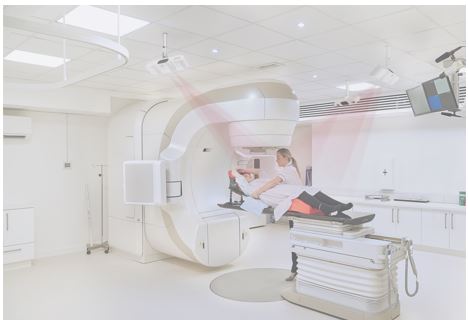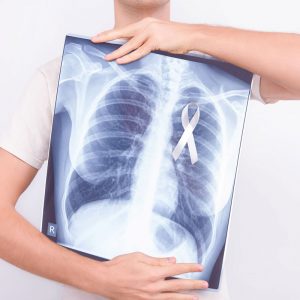AlignRT® is an innovative technology which increases treatment accuracy and patient comfort during radiation therapy.
What is AlignRT?

Quickly growing in use around the world, AlignRT® uses a 3D camera system to track your body surface in real time and may be used to help position you accurately before radiation therapy, and ensure you keep that position during treatment. Using your external skin surface, the technology monitors your movement and knows exactly where you are at any moment to within a fraction of a millimeter. AlignRT® can be used from head to toe.
How does it work?
AlignRT® is a system of cameras, mounted to the ceiling, that feed data into a software program. Each camera unit uses a projector and image sensors to create a 3D surface model of the area by projecting a red light (containing a pseudo-random speckle pattern) on your skin. The speckled pattern allows AlignRT® to reference thousands of points on the skin, acting as virtual tattoos. This imaging information is fed into software program that allows real time, accurate tracking during your set up and radiotherapy treatment, making sure your radiation therapist is alerted if you move from the optimal position, and in many cases automatically pausing treatment if this happens.
Why should I choose a center with AlignRT® for my radiation therapy treatment?
The American Society for Radiation Oncology (ASTRO) issued treatment guidelines for breast cancer patients in 2018. These guidelines state that, “Approaches that incorporate deep inspiration breath hold, target and organ-at-risk contouring and optimal patient positioning are recommended to minimize the radiation dose affecting nearby organs and normal tissue, including the heart, lungs and opposite breast.”¹ (our emphasis)
AlignRT® has been shown to help deliver this “optimal patient positioning”, across many different cancer treatment sites, and is commonly used for “deep inspiration breath hold”. There are many scientific studies published in journals with an excellent reputation, describing the accuracy of this technique. Vision RT systems are deployed in 15 of the top 15 US News “Best Hospitals for Cancer” and have been extensively studied with over 100 published clinical studies.

Accuracy
AlignRT® sets up and tracks your radiation treatment position with submillimeter†,accuracy.

Protection for left-breast cancer
In a study, patients followed up six months after treatment with DIBH and AlignRT® were shown to be free of any abnormalities in blood flow to the heart. In an earlier study during which left breast cancer patients were treated conventionally, 27% exhibited blood flow abnormalities after six months.² ³

Tattoo & mark-free treatment options
Accurate positioning and motion tracking may eliminate the need for you to have permanent tattoos.⁴
Left-Breast
A study suggests that AlignRT® + Deep Inspiration Breath Hold (DIBH) can prevent abnormalities in blood flow to the heart resulting from left-breast radiation therapy.²
Brain
AlignRT® in stereotactic radiosurgery (SRS) has shown clinically equivalent results, with better patient comfort and fast treatment times, compared with other commonly-used, more invasive technologies.⁵ ⁶
Lung and Liver
AlignRT® has been shown to help treat stereotactic body radiation therapy patients with better than patients with accurate initial setup and monitoring during treatment and relatively little immobilization which leads to enhanced comfort.⁷
Head and Neck
AlignRT® offers a more comfortable radiation treatment while making sure that the treatment is as accurate as treatments with a full-face mask.
Children
AlignRT® offers many benefits to pediatric patients, including easier set up, avoiding tattoos, and may reduce the need for general anesthesia in children.
Listen to radiation specialists share their insights about AlignRT® , how it is becoming the new standard of radiation therapy, and the benefits it can provide for you.
If you are being recommended radiation treatment, yes. Of course, all patients’ cancer treatments and options are different so make sure you discuss the use of AlignRT® as part of your radiation treatment with your oncologist.
To support your conversation with your doctor, please feel free to use our downloadable discussion guide.
To easily find an AlignRT® center near you, use our Treatment Center Locator.
1. Radiation therapy for the whole breast: Executive summary of an American Society for Radiation Oncology (ASTRO) evidence-based guideline Smith, Benjamin D. et al. Practical Radiation Oncology, Volume 8, Issue 3, 145 – 152
2. Zagar et al. Prospective Assessment of Deep Inspiration Breath Hold to Prevent Radiation Associated Cardiac Perfusion Defects in Patients With Left-Sided Breast Cancer J Appl Clin Med Phys. ;93:3S 2027, plus recent personal communication.
3. Zagar et al. Prospective Assessment of Deep Inspiration Breath Hold to Prevent Radiation Associated Cardiac Perfusion Defects in Patients With Left-Sided Breast Cancer J Appl Clin Med Phys. ;93:3S 2027, plus recent personal communication.
4. Herron 2018 – Surface guided radiation therapy as a replacement for patient marks in treatment of breast cancer.
5. Pan et al. Frameless, real-time, surface imaging-guided radiosurgery: clinical outcomes for brain metastases. Neurosurgery. 2012 Oct;71(4):844-51
6. Pham et al. Frameless, real-time, surface imaging-guided radiosurgery: update on clinical outcomes for brain metastases. Trans. Cancer Res, 3, 4, 351-357, August, 2014
7. Heinzerling JH, et al. Use of 3d optical surface mapping for quantification of interfraction set up error and intrafraction motion during stereotactic body radiation therapy treatments of the lung and abdomen. International Journal of Radiation Oncology • Biology • Physics 2017;99 (2):E670.
8. Gierga et al. A Voluntary Breath-Hold Treatment Technique for the Left Breast With Unfavorable Cardiac Anatomy Using Surface Imaging. Int J Radiat Oncol Biol Phys. 2012 Dec 1;84(5):e663-8:





